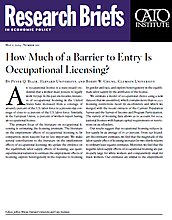The primary focus of the literature on occupational licensing is estimating the licensing premium. The literature on the employment effects of occupational licensing is, by comparison, more nascent but no less important. We make several contributions to the literature on the employment effects of occupational licensing: we update the evidence on the equilibrium labor supply effects of licensing, use quasi-experimental variation to estimate the employment effects of licensing, explore heterogeneity in the response to licensing by gender and race, and explore heterogeneity in the equilibrium labor supply by the attributes of the license.
We estimate a model of occupational choice using a new data set that we assembled, which contains more than 16,000 licensing restrictions faced by ex-offenders and which we merged with the recent extracts of the Current Population Survey and the Survey of Income and Program Participation. The variety of licensing data allows us to account for occupational licenses with human capital requirements or restrictions on ex-offenders.
Our results suggest that occupational licensing reduces labor supply by an average of 17–27 percent. From our boundary discontinuity estimates, we find that the magnitude of the labor-supply effect of licensing increases by two-thirds relative to ordinary least squares estimates. Moreover, we find that the negative labor-supply effects of occupational licensing are particularly large for white workers and comparatively small for black workers. Our estimates are similar to the employment effects reported by economist Morris Kleiner, who has shown that partially licensed occupations grow at a rate of 20 percent less than unlicensed occupations. Our estimates are also in line with the estimates by Janna Johnson and Kleiner, who found that state-specific licensing laws reduce interstate mobility of workers by 36 percent, whereas national licensing has no negative effect on interstate mobility of workers.
A full version of this paper and our related work on the effect of occupational licensing on racial and gender wage gaps can be found on the NBER Working Paper Series: https://www.nber.org/people/peter_blair.
NOTE:
This research brief is based on Peter Q. Blair and Bobby W. Chung, “How Much of a Barrier to Entry Is Occupational Licensing?,” NBER Working Paper no. 25262, November 2018, http://www.nber.org/papers/w25262.

